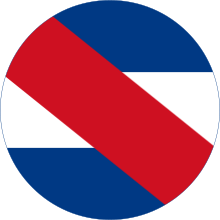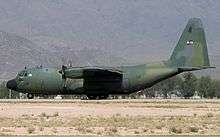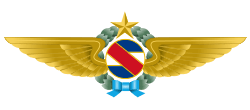Uruguayan Air Force
| Uruguayan Air Force | |
|---|---|
| Fuerza Aérea Uruguaya | |
|
FAU emblem. | |
| Active | April 1, 1935 |
| Country |
|
| Branch | Air Force |
| Type | Military aviation |
| Role | "To defend the honor, the independence, and the peace of the Republic, the integrity of its territory, its constitution and its laws. To be an exemplary Air Force, though small according to the possibilities of the country, with a high degree of professionalism and skill, with modern and suitable equipment, capable of dissuasion and being a pride to the nation."[1] |
| Size | 2.148 |
| Part of | Armed Forces of Uruguay |
| Nickname(s) | FAU |
| Motto(s) | Aviation vanguard of the homeland |
| Colors | Blue, red and white |
| March | FAU march |
| Mascot(s) | Southern lapwing |
| Anniversaries |
17 March: Air Force Day 10 August: Day of the Martyrs of Military Aviation |
| Aircraft | 89 |
| Website | http://www.fau.mil.uy/ |
| Commanders | |
| Commander in chief of the Air Force | Air Force General Alberto Zanelli |
| National Director of Civil Aviation and Aviation Infrastructure | Brigadier General Antonio Alarcón |
| Commander of Air Command Operations | Brigadier General Ismael Alonzo |
| Commander of Air Command Staff | Brigadier General Luis Pepelescov |
| Chief of General Staff | Brigadier General Hugo Marenco |
| Commander of the Air Logistics Command | Brigadier General José Visconti |
| Insignia | |
| Roundel |
 |
| Fin Flash |
 |
| Aircraft flown | |
| Attack |
A-37 Dragonfly IA-58 Pucará |
| Helicopter |
AS365 Dauphin UH-1 Iroquois Bell 212 |
| Trainer |
T-6 Texan SF.260 PC-7 Turbo Trainer |
| Transport |
C-212 Aviocar C-130 Hercules EMB-110 Bandeirante EMB-120 Brasilia |
|
Beechcraft Baron PA-18 Super Cub T-41 Mescalero Cessna 206 | |
The Uruguayan Air Force (Spanish: Fuerza Aérea Uruguaya, abbreviated FAU) is one of the three main branches of the Armed Forces of Uruguay under the Uruguayan Ministry of Defense.
History
XX century
Military aviation in Uruguay was born on 17 March 1913 when the Military Aviation Academy (Escuela de Aviación Militar) was formed at a small airport 50 km from Montevideo. The first aircraft were a Farman Longhorn biplane and a Blériot XI monoplane. As with many other Latin American countries, flight instruction was initially performed by a European (in this case French) instructor. Ten army officers formed the select group chosen to be the first Uruguayan military aviators. Among them were Cpt Juan Manuel Boiso Lanza and Lt. Cesáreo L. Berisso. Boiso Lanza was the first fatality of the FAU, dying in a plane crash on 10 August 1918; he later became the namesake of Cpt Boiso Lanza Air Base in Montevideo, the current FAU headquarters. Berisso became the first commander of the Air Force flight school and was later the namesake of Gen. Cesáreo Berisso Air Base in Carrasco, the headquarters of Air Brigade I.
Along with two other young officers, Adhemar Saenz Lacueva and Esteban Cristi, they gained their military aviator rating in Argentina and Chile and formed the Military Aeronautical School on 20 November 1916. This school was the only military aviation facility in Uruguay until 1935. Several European aircraft types were used in fairly large numbers during the twenties, among them sixteen Avro 504Ks, thirteen Breguet 14s, five Castaibert 913-IVs, twenty-eight Nieuport 27s. These pioneering years saw many air routes opened and an overall increase in the awareness of the military potential of this nascent force.
In 1935 the school was transformed into the Military Aeronautics division (Aeronáutica Militar,) and five units were created as well as several airbases. Typical aircraft of the thirties and forties were European types like the Potez XXV A.2 TOE, the SPAD S.VII and S.XIII, the de Havilland DH 82A, and the IMAM Ro.37; but this era also saw the transition to aircraft of American pedigree. Beech AT-11 and Douglas C-47 transports, Waco JHD and NAA Texan trainers, and NAA B-25J bombers were used in this period. The arrival of F-51 Mustangs in the early 50s notably enhanced the capabilities of the air force. There were now nine Aviation Groups and the Military Aeronautics division was officially renamed the Military Air Force (Fuerza Aérea Militar) on 4 December 1952. This change in nomenclature was important because it signified the independence of the branch from the army command structure. The new force was reorganized into three commands (tactical, training, and material) and a brigade structure was implemented along with a fully staffed headquarters.
The Uruguayan Air Force grew from this foundation. Later, some new units were created such as the Aerial Commands, but no radical changes were made. The FAU received its first jets when Lockheed T-33s and F-80s arrived in 1955 and 1958.[2] The FAU also employed the de Havilland Chipmunk, using 10 from 1954 to 1962. The first helicopters were Bell 47s and Hiller H-23Fs, followed by the venerable Bell UH-1B Hueys.
Present
A substitute for the two Lockheed C-130B is needed in near time, despite the Program Depot Maintenance(PDM) and major upgrade realized by Chilean aircraft manufacturer ENAER.[3][4] Candidates are the EADS CASA C-295 and possibly Shaanxi Y-8 despite no official statement has been done. In the medium and light transport branch Bandeirantes are being restored to flight by Algar Aviation in Brazil since the end of 2013.[5][6] In 2009 two CASA C-212 were bought from Sweden as a temporary solution and another two former-Portuguese Air Force C-212-300 are to be incorporated in 2015.[7][8] China has offered Harbin Y-12 and rumours about a purchase of some Cessna 208 were deny recently.
The Uruguayan Air Force is looking for a new fighter plane as its fleet of Dragonflies are reaching the end of their operative life. In May 2013 eighteen refurbished Sukhoi Su-30 MkI were offered by the Russian Federation and Sukhoi in remarkably favorable conditions that included credit facilities and an agreement branch for maintenance. These conditions were offered for the Yak-130 Mitten, too. By December 2013 Uruguayan personnel flew this plane in Russia.[9] Current negotiations are ongoing.[10]
According to Scramble a number of A-37B Dragonfly were purchased from the Ecuadorian Air Force in January 2014. In August 2014 the Uruguayan and Swiss governments discussed a possible agreement for the purchase of ten Swiss Air Force Northrop F-5 plus engines, spare parts and training.[11]
Also, the FAU showed interest on the IA-58D Pucará Delta modernization program offered by Fábrica Argentina de Aviones.[12]
Organization
Today the FAU comprises about 3000 personnel organized into three brigades and various support groups.
- Air Brigade I was founded as Nº1 Aeronautics on 1 April 1936. It originally consisted of eight Potez XXV biplanes. Today, the brigade includes the Central Office for Assistance and the Carrasco Central Coordinator for Rescue. It also includes
- Nº3 Squadron (Transport) and
- Nº5 Squadron (Helicopters).
- Air Brigade II includes
- Nº1 Squadron (Attack),
- Nº2 Squadron (Fighters),
- the Advanced Flight Squadron, and
- the Liaison Squadron.
- Air Brigade III includes
- Nº7 Squadron (Observation & Liaison).
The Uruguayan Air Force also includes Service divisions for Logistics, Communications and Computer Science, Information, Infrastructure, Maintenance, Meteorology, Health, Remote Aerospace Sensors, and Transport. The FAU is involved in search and rescue, disaster assistance, and transportation to remote locations within the country.
The Uruguayan Air Force currently has five bases. Air Brigade I is based at Gen. Cesáreo L. Berisso Air Base at Carrasco International Airport (SUMU) near Carrasco; Air Brigade II is based at 2nd Lt. Mario W. Parrallada Air Base at Santa Bernardina International Airport (SUDU) in Durazno; Air Brigade III, the high command, and the Command School (Escuela de Comando y Estado Mayor Aéreo) are based at Capitán Boiso Lanza Air Base (SUBL) in Montevideo; Air Squadron 7 is based at Ángel S. Adami Airport (SUAA), also in Montevideo; and the EMA is based at Gen. Artigas Air Base(SUGA) in Pando.[13]
The Aeronautics Technical School (Escuela Técnica de Aeronáutica) is located in Toledo Sur in the Department of Canelones.[14]
Aircraft
.jpg)
.jpg)

Current inventory
| Aircraft | Origin | Type | Variant | In service | Notes | |
|---|---|---|---|---|---|---|
| Combat Aircraft | ||||||
| Cessna A-37 | United States | attack | 8[15] | |||
| IA 58 Pucará | Argentina | attack | 5[15] | |||
| Maritime Patrol | ||||||
| CASA C-212 | Spain | SAR / maritime patrol| | 4[15] | |||
| Transport | ||||||
| C-130 Hercules | United States | transport | C-130B | 2[15] | ||
| CASA C-212 | Spain | transport | 1[15] | |||
| Embraer EMB 120 | Brazil | utility / VIP | 1[15] | |||
| Embraer EMB 110 | Brazil | utility / transport | 2[15] | |||
| Helicopters | ||||||
| Bell UH-1 | United States | utility | UH-1H | 3[15] | ||
| Bell 212 | United States | utility | 3[15] | |||
| Eurocopter AS365 | France | utility | 2[15] | |||
| Trainer Aircraft | ||||||
| Pilatus PC-7 | Switzerland | trainer | 5[15] | |||
| SIAI-Marchetti SF.260 | Italy | trainer | 5[15] | |||
Rank structure
Officers wear their rank insignia on their sleeves; the insignia are nearly identical to that used by the RAF and air forces of Commonwealth nations.[16]
| Equivalent NATO Rank Code | Rank in Spanish | Rank in English | Commonwealth equivalent | US Air Force equivalent |
|---|---|---|---|---|
| OF-8 | General del Aire | Lieutenant General | Air Marshal | Lieutenant General |
| OF-7 | Brigadier General | Major General | Air Vice-Marshal | Major General |
| OF-5 | Coronel | Colonel | Group Captain | Colonel |
| OF-4 | Teniente Coronel | Lieutenant Colonel | Wing Commander | Lieutenant Colonel |
| OF-3 | Mayor | Major | Squadron Leader | Major |
| OF-2 | Capitán | Captain | Flight Lieutenant | Captain |
| OF-1 | Teniente Primero | First Lieutenant | Flying Officer | First Lieutenant |
| OF-1 | Teniente Segundo | Second Lieutenant | Pilot Officer | Second Lieutenant |
| OF-D | Alférez | Ensign | Acting Pilot Officer |
See also
- Armed Forces of Uruguay
- History of Uruguay
- National Navy of Uruguay, which includes a Naval Aviation contingent
- Uruguayan Air Force Flight 571
References
| Wikimedia Commons has media related to Air force of Uruguay. |
Notes
- ↑ Fuerza Aérea Uruguaya, (2008). . Retrieved 2 October 2008.
- ↑ Air International August 1990, p. 73.
- ↑ "Actualizado: ENAER modernizará aeronaves C-130B de la FAU" (in Spanish). ModoCharlie. October 7, 2011. Retrieved December 21, 2014.
- ↑ "La Fuerza Aérea Uruguaya contrata a ENAER para el mantenimiento de un C-130B Hercules" (in Spanish). April 20, 2012. Retrieved December 21, 2014.
- ↑ "La Fuerza Aérea Uruguaya continúa ejecutando su plan de mantenimiento de aeronaves" (in Spanish). InfoDefensa. September 24, 2013. Retrieved December 21, 2014.
- ↑ "La Fuerza Aérea Uruguaya repara y adquiere repuestos para sus aeronaves" (in Spanish). Paz la Nueva Radio. November 28, 2013. Retrieved December 21, 2014.
- ↑ "La Fuerza Aérea Uruguaya confirma la compra de aviones C212-300MP" (in Spanish). InfoDefensa. July 31, 2014. Retrieved December 21, 2014.
- ↑ "Portugal y Uruguay suscriben el contrato de transferencia de dos C212-300 para la FAU" (in Spanish). Defensa. December 19, 2014. Retrieved December 21, 2014./
- ↑ "La Fuerza Aérea Uruguaya evalúa el jet de entrenamiento YAK-130 en Rusia" (in Spanish). December 12, 2013. Retrieved December 21, 2014.
- ↑ "Mujica negocia la compra de seis aviones rusos para Fuerza Aérea" (in Spanish). El Observador. July 15, 2014. Retrieved December 21, 2014./
- ↑ "F-5 suizos a Uruguay" (in Spanish). August 21, 2014. Retrieved December 21, 2014.
- ↑ "Argentina y Uruguay estudiaron la modernización de los aviones IA-58 Pucará" (in Spanish). July 10, 2014. Retrieved December 21, 2014./
- ↑ Aeroflight, (2008). . Retrieved 2 October 2008.
- ↑ Fuerza Aérea Uruguaya, (2008). . Retrieved 2 October 2008.
- 1 2 3 4 5 6 7 8 9 10 11 12 "World Air Forces 2016 pg. 33". Flightglobal Insight. 2016. Retrieved 29 October 2016.
- ↑ Insignias
Bibliography
- "Shoestring Top Cover...The Uruguayan Air Force". Air International, Vol. 39 No. 2, August 1990. pp. 65–73.
External links
- Fuerza Aérea Uruguaya - Official website (in Spanish)
- "Memories from the Age of Flight" (in Spanish)
- The Fuerza Aerea Uruguaya in Microsoft Flight Simulator FS2004 (in Spanish)
- Aeroflight: Uruguay Air Force
